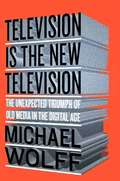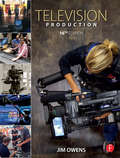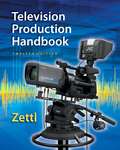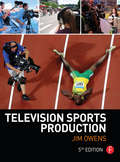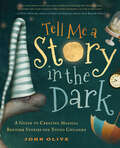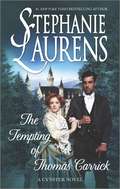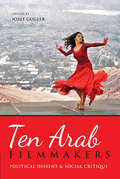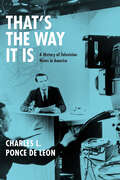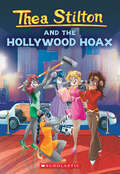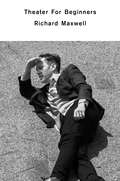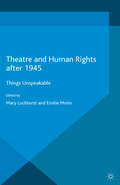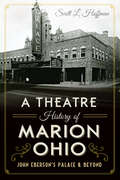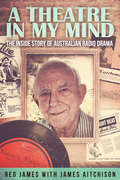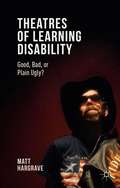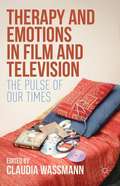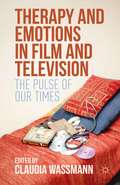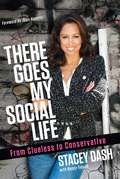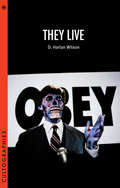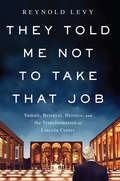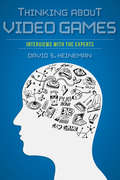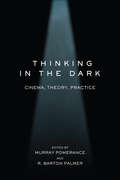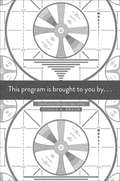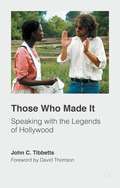- Table View
- List View
Techno-Orientalism
by Jinny Huh Catherine Fung Abigail De Kosnik Seo-Young Chu Dylan Yeats Kathryn Allan Julie Ha Tran Aimee Bahng Jason Crum Tzarina T. Prater Douglas S. Ishii Greta A. Niu Kenneth Hough Betsy Huang Se Young Kim Warren Liu Victor Bascara David S. Roh Steve Choe Charles ParkWhat will the future look like? To judge from many speculative fiction films and books, from Blade Runner to Cloud Atlas, the future will be full of cities that resemble Tokyo, Hong Kong, and Shanghai, and it will be populated mainly by cold, unfeeling citizens who act like robots. Techno-Orientalism investigates the phenomenon of imagining Asia and Asians in hypo- or hyper-technological terms in literary, cinematic, and new media representations, while critically examining the stereotype of Asians as both technologically advanced and intellectually primitive, in dire need of Western consciousness-raising. The collection's fourteen original essays trace the discourse of techno-orientalism across a wide array of media, from radio serials to cyberpunk novels, from Sax Rohmer's Dr. Fu Manchu to Firefly. Applying a variety of theoretical, historical, and interpretive approaches, the contributors consider techno-orientalism a truly global phenomenon. In part, they tackle the key question of how these stereotypes serve to both express and assuage Western anxieties about Asia's growing cultural influence and economic dominance. Yet the book also examines artists who have appropriated techno-orientalist tropes in order to critique racist and imperialist attitudes. Techno-Orientalism is the first collection to define and critically analyze a phenomenon that pervades both science fiction and real-world news coverage of Asia. With essays on subjects ranging from wartime rhetoric of race and technology to science fiction by contemporary Asian American writers to the cultural implications of Korean gamers, this volume offers innovative perspectives and broadens conventional discussions in Asian American Cultural studies.
Television Is the New Television
by Michael Wolff"The closer the new media future gets, the further victory appears." --Michael WolffThis is a book about what happens when the smartest people in the room decide something is inevitable, and yet it doesn't come to pass. What happens when omens have been misread, tea leaves misinterpreted, gurus embarrassed?Twenty years after the Netscape IPO, ten years after the birth of YouTube, and five years after the first iPad, the Internet has still not destroyed the giants of old media. CBS, News Corp, Disney, Comcast, Time Warner, and their peers are still alive, kicking, and making big bucks. The New York Times still earns far more from print ads than from digital ads. Super Bowl commercials are more valuable than ever. Banner ad space on Yahoo can be bought for a relative pittance.Sure, the darlings of new media--Buzzfeed, HuffPo, Politico, and many more--keep attracting ever more traffic, in some cases truly phenomenal traffic. But as Michael Wolff shows in this fascinating and sure-to-be-controversial book, their buzz and venture financing rounds are based on assumptions that were wrong from the start, and become more wrong with each passing year. The consequences of this folly are far reaching for anyone who cares about good journalism, enjoys bingeing on Netflix, works with advertising, or plans to have a role in the future of the Internet.Wolff set out to write an honest guide to the changing media landscape, based on a clear-eyed evaluation of who really makes money and how. His conclusion: the Web, social media, and various mobile platforms are not the new television. Television is the new television.We all know that Google and Facebook are thriving by selling online ads--but they're aggregators, not content creators. As major brands conclude that banner ads next to text basically don't work, the value of digital traffic to content-driven sites has plummeted, while the value of a television audience continues to rise. Even if millions now watch television on their phones via their Netflix, Hulu, and HBO GO apps, that doesn't change the balance of power. Television by any other name is the game everybody is trying to win--including outlets like The Wall Street Journal that never used to play the game at all.Drawing on his unparalleled sources in corner offices from Rockefeller Center to Beverly Hills, Wolff tells us what's really going on, which emperors have no clothes, and which supposed geniuses are due for a major fall. Whether he riles you or makes you cheer, his book will change how you think about media, technology, and the way we live now.From the Hardcover edition.
Television Production, 16th Ed.
by Jim OwensGain the skills you need to succeed in the television industry and master the production process, from shooting and producing, to editing and distribution. This new and updated 16th edition of Television Production offers a thorough and practical guide to professional TV and video production techniques. You will learn how to anticipate and quickly overcome commonly-encountered problems in television production, as Jim Owens details all the major features of television production, including the secrets of top-grade camerawork, persuasive lighting techniques, effective sound treatment, as well as the subtle processes of scenic design, and the art of video editing. The 16th edition of this classic text now explores the changing television landscape, the effects of the "second screen" on viewer experience, 4K and 8K shooting and the real implications it has for your production, and much more. This new edition also includes:<P><P> * Discussions on the changing definition of "television" and how new technology effects veiwers and their viewing habits<P> * Updated interviews with professionals in the industry, such as noted documentary filmmaker, Sarah Leckie, about the challenges they face during the production process and the advice they would give to those trying to break in to the production and television industries<P> * Thorough definitions of television and production terminology as well as information on LED lighting and other technologies used on set<P> * A comprehensive resource page for instructors, containing slides and testing materials to aid in the learning process can be found at www.focalpress.com/cw/owens.
Television Production Handbook (Twelfth Edition)
by Herbert ZettlIn the field-defining text TELEVISION PRODUCTION HANDBOOK, author Herbert Zettl emphasizes how production proceeds in the digital age-from idea to image-and how it moves through the three major phases, from preproduction to production to postproduction. In this context, readers will learn about the necessary tools, examine what they can and cannot do, and explore how they are used to ensure maximum efficiency and effectiveness. This edition features the latest digital equipment and production techniques, including including stereo 3D, 3D camcorders, 4K and 8K digital cinema cameras, portable switchers, LED lighting instruments, and digital lighting control systems.
Television Sports Production
by Jim OwensUnlike a studio production, many factors can adversely affect your television sports shoot including weather, lighting, and natural sound. A successful shoot is dependent on extensive planning, careful budgetting, technology, location, and a thorough understanding of the intricacies of the sport itself. With so much at stake, why not learn from an expert? In Television Sports Production, Fifth Edition Jim Owens walks you through the planning, set-up, directing, announcing, shooting, and editing involved with covering a sports event. This manual gives you the tools to effectively cover sports ranging such as football, soccer, and basketball. Tips and advice on using mobile units, cameras, audio equipment, and lighting rigs will enable you to produce live or recorded coverage like an expert and capture professional-quality footage on the first take. After all, there are no instant replays! This new edition has been updated to include: Techniques used by producers to capture the essence of individual Tips on shooting in 3D, 5D, 4k and 8K Coverage using surround sound and the second screen Extras such as camera and microphone diagrams and an easy-reference glossary
Tell Me a Story in the Dark: A Guide to Creating Magical Bedtime Stories for Young Children
by John OliveTonight, don't read your child a story. Instead, dim the light, lie down, and create storytelling magic. Weave a spell that will enchant your child. . .Written by an award-winning playwright, Tell Me A Story In The Dark provides you with every tool you need to tell great and entertaining stories. In a day when parents want to spend more quality time with their children, Tell Me A Story In The Dark:Shows you how to prepare and tell a story.Communicates the enormous benefits—ending the bedtime battle of wills, building vocabulary, making room for effective parenting moments.Provides a treasure trove of stories that parents (and grandparents) can adapt for their children.Teaches you how to make up and tell your own stories.Anyone who loves children will love this book.
The Tempting of Thomas Carrick (Cynster #33)
by Stephanie Laurens#1 New York Times bestselling author Stephanie Laurens returns to Scotland with a tale of two lovers irrevocably linked by destiny.<P><P> Thomas Carrick is driven to control all aspects of his life. The wealthy owner of Carrick Enterprises, located in bustling Glasgow, he is one of that city's most eligible bachelors and intends to select a wife from the many young ladies paraded before him. He wants to take that next step along his self-determined path, yet no one captures his eye, nor his attention…not the way Lucilla Cynster did.<P> Thomas has avoided his clan's estate because it borders Lucilla's home, but disturbing reports from his clansmen force him to return. His uncle, the laird, is ailing, a family is desperately ill, and the healer is unconscious and dying. Duty leaves Thomas no choice but to seek help from the last woman he wants to face.<P> Strong-willed and passionate, Lucilla has been waiting for Thomas to return and claim his place by her side. She knows he is her fated lover, husband, protector, and mate just as she is his one true love. Though his return wasn't on her account, Lucilla is willing to seize whatever chance Fate hands her.<P> Thomas can never forget Lucilla, or the connection that seethes between them, but to marry her would mean embracing a life he does not want.<P> Lucilla sees that Thomas has yet to accept the inevitability of their union. But how can he ignore a bond such as theirs—one so much stronger than reason? Lucilla is as determined as only a Cynster can be to fight for the future she knows can be theirs. And while she cannot command him, she has powerful enticements she's willing to wield in the tempting of Thomas Carrick. <P> A neo-Gothic tale of passionate romance laced with mystery, set in the uplands of southwestern Scotland
Ten Arab Filmmakers
by Josef GuglerTen Arab Filmmakers provides an up-to-date overview of the best of Arab cinema, offering studies of leading directors and in-depth analyses of their most important films. The filmmakers profiled here represent principal national cinemas of the Arab world -- Algeria, Egypt, Lebanon, Morocco, Palestine, and Syria. Although they have produced many of the region's most-renowned films and gained recognition at major international festivals, with few exceptions these filmmakers have received little critical attention. All ten share a concern with giving image and voice to people struggling against authoritarian regimes, patriarchal traditions, or religious fundamentalism--theirs is a cinéma engagé.The featured directors are Daoud Abd El-Sayed, Merzak Allouache, Nabil Ayouch, Youssef Chahine, Mohamed Chouikh, Michel Khleifi, Nabil Maleh, Yousry Nasrallah, Jocelyne Saab, and Elia Suleiman.
That's the Way It Is: A History of Television News in America
by Charles L. Ponce de LeonWhen critics decry the current state of our public discourse, one reliably easy target is television news. It s too dumbed-down, they say; it s no longer news but entertainment, celebrity-obsessed and vapid. The critics may be right. But, as Charles L. Ponce de Leon explains in "That s the Way It Is," TV news has "always" walked a fine line between hard news and fluff. The familiar story of decline fails to acknowledge real changes in the media and Americans news-consuming habits, while also harking back to a golden age that, on closer examination, is revealed to be not so golden after all. Ponce de Leon traces the entire history of televised news, from the household names of the late 1940s and early 50s, like Eric Sevareid, Edward R. Murrow, and Walter Cronkite, through the rise of cable, the political power of Fox News, and the satirical punch of Colbert and Stewart. He shows us an industry forever in transition, where newsmagazines and celebrity profiles vie with political news and serious investigations. The need for ratings success and the lighter, human interest stories that can help bring it Ponce de Leon makes clear, has always sat uneasily alongside a real desire to report hard news. Highlighting the contradictions and paradoxes at the heart of TV news, and telling a story rich in familiar figures and fascinating anecdotes, "That s the Way It Is" will be the definitive account of how television has showed us our history as it happens. "
Thea Stilton and the Hollywood Hoax: A Geronimo Stilton Adventure (Thea Stilton #23)
by Thea StiltonJoin Thea Stilton and the Thea Sisters on an adventure packed with mystery and friendship!The Thea Sisters are visiting a friend in sunny California -- and she invites them to the set of a movie in Hollywood! The mice love being around famouse and fabumouse directors and actors as they're working. But then an important reel of film is stolen from the studio! Can the Thea Sisters catch the thief and save the movie?
Theater for Beginners
by Richard MaxwellRichard Maxwell, the downtown writer and director with a deadpan aesthetic and an ever-innovative body of work, has written a quasi-study guide to the art of making theater according to his "affecting affectless technique" (New York Times...) This illuminating volume will provide students and artists with a deeper understanding of Maxwell's work, aesthetic philosophy, and process for creating theater.
Theatre and Human Rights after 1945: Things Unspeakable
by Mary Luckhurst Emilie MorinThis volume investigates the rise of human rights discourses manifested in the global spectrum of theatre and performance since 1945. Essays address topics such as disability, discrimination indigenous rights, torture, gender violence, genocide and elder abuse.
A Theatre History of Marion, Ohio: John Eberson's Palace And Beyond (Landmarks)
by Scott L. HoffmanOne of the last remaining atmospheric theatres in the nation, elegant Marion Palace Theatre holds a storied history behind its curtains. From the "Wigwam," the Grand Opera House and Germania Park Pavilion to nickelodeons, vaudeville houses and movie theatres, performance has been an essential part of Marion's history, and the Palace is the city's jewel. Designed by renowned theatre architect John Eberson, the Palace opened its doors in 1928 to packed audiences of over three thousand patrons. Author Scott L. Hoffman delves into the life and work of John Eberson and the forgotten stories of the Palace that include a police gambling raid, the construction of the theatre and the stars who performed for dazzled audiences there.
A Theatre in my Mind
by James Aitchison Reg JamesRadio drama is often called the "theatre of the mind", wherein a listener's imagination is stimulated by voices, sounds, and music to create mental imagery as real as any bricks-and-mortar theatre. Reg James spent a lifetime in the thick of Australian radio drama. Rising through the ranks at Grace Gibson Radio Productions -- from despatch boy to general manager -- he takes us behind the scenes into the fascinating world of broadcasting from the 1930s to the present day. The great shows, the magic voices, the pure drama of putting shows to air -- Reg shares his secrets and stories in this amazing journey back in time to a lost era. With co-author James Aitchison, Reg invites you to join him in this unique theatre. Essential reading for anyone who enjoyed listening to radio serials, and for those fascinated by Australian radio. Authors of Yes, Miss Gibson, the biography of Grace Gibson.
Theatres of Learning Disability
by Matt HargraveThis is the first scholarly book to focus exclusively on theatre and learning disability as theatre – rather than advocacy or therapy. Matt Hargrave provocatively realigns many of the (hitherto unvoiced) assumptions that underpin such practices, and opens up a new set of critical questions. Stemming from a close engagement with the work of several very different theatre companies – including Mind the Gap (UK); Back to Back (Australia) - and unique solo artists such as Jez Colborne, this book shifts the emphasis from questions of social benefit towards a genuine engagement with aesthetic judgement. Hargrave examines the rich variety of contemporary theatrical practices in this field and spans a wide range of forms such as site specific, naturalistic and autobiographical performance. The book examines ways in which the learning disabled performer might be read on stage, and the ways in which s/he might disturb assumptions, not least about what acting or artistic authorship is. This is an important and timely study for all upper-level theatre and performance students and scholars alike, as well as a provocative contribution to debates within disability studies.
Therapy and Emotions in Film and Television: The Pulse Of Our Times
by Claudia WassmannTherapy and Emotions in Film and Television.
Therapy and Emotions in Film and Television: The Pulse of Our Times
by Claudia WassmannTherapy and Emotions in Film and Television explores, from an interdisciplinary perspective, the shifts in our emotional preferences, styles, and 'emotional regimes' in western societies from the 1920s to today, as viewed through the lens of film and television.
There Goes My Social Life: From Clueless to Conservative
by Stacey DashIn 2012, actress Stacey Dash posted a tweet that changed her life. Up until that moment, Dash had lived a typical Hollywood life: Best known for playing Dionne in the 1995 teen classic Clueless, Dash had close friends in the upper echelons of the movie and music industries-and she had an Obama bumper sticker on the back of her BMW. But in 2012, sick of being disappointed by the Obama White House and growing more certain of her conservative beliefs, Dash endorsed Mitt Romney for president on Twitter. The backlash was swift and brutal.In There Goes My Social Life, Stacey Dash explains how she became a conservative, sharing incredible stories of her rough upbringing in South Bronx and her tumultuous Hollywood career to movingly illustrate her strong opinions about the value of a good education, the importance of family, the inanity of political correctness, and the power of personal responsibility.
They Live
by Wilson D. HarlanTraces the development of They Live from its comic book roots to its legacy as a cult masterpiece while evaluating the film in light of paranoid/postmodern theory
They Live
by D WilsonTraces the development of They Live from its comic book roots to its legacy as a cult masterpiece while evaluating the film in light of paranoid/postmodern theory
They Told Me Not to Take that Job: Tumult, Betrayal, Heroics, and the Transformation of Lincoln Center
by Reynold LevyReynold Levy joined Lincoln Center in 2002. When he did so America’s leading arts venue was routinely described in terms like this: "Behind the scenes, however, Lincoln Center is a community in deep distress, riven by conflict over a grandiose $1 billion redevelopment plan... instead of uniting the Center’s constituent arts organizations behind a common goal, the project has pitted them against one another in open warfare more reminiscent of the shoot-out at the OK Corral than of a night at the opera. 'To say that it is a mess is putting it mildly,’ says Johanna Fiedler, the author and a former staff member at the Metropolitan Opera. 'There is nobody running the show right now. ’” (Leslie Bennetts, New York Magazine¸ February 4, 2002) To choose to be President of Lincoln Center of one’s own free will was regarded by Reynold Levy’s friends and mentors as bordering on a self-destructive act. Rivalries abounded. Personalities clashed. Egos reigned. Reputations were badly damaged. And many of the tensions were dramatically played out in public and assiduously reported by a delighted press. Levy had just spent six years traipsing through much of the Third World and many failed states as the President of the International Rescue Committee (IRC), one of the world’s leading refugee assistance organizations. Having dealt with the Democratic Republic of Congo, Rwanda, and Serbia, even Joe Volpe, the volcanic manager of the Metropolitan Opera seemed hardly daunting. Lincoln Center, its key figures with their bombast and betrayals was not South Sudan. So he set to, and during his presidency transformed Lincoln Center’s entire 16-acre campus including the city block from Broadway to Amsterdam Avenue. With the new Alice Tully Hall, the expansion of The Juilliard School, two new screening rooms and an education center for the Film Society, new dance studios for the School of American Ballet, came a beautifully designed, graceful welcome to Lincoln Center’s main campus, one filled with light and life. There were new green spaces, new restaurants, a totally wifi’d campus that displayed 21st Century technology indoors and out. And a remodeled, utterly transformed, privately owned public space called the David Rubenstein Atrium, named after its principal donor, a new Lincoln Center Commons, opened free of charge to the public 365 days a year. This book reveals the real story behind the 1. 2 billion dollar reinvention of Lincoln Center, and all the trials and triumphs along the way. It contains unique lessons for leaders in all kinds of organizations, cautionary tales for employees, volunteers and donors, and inspiring clarity for anyone who wants to lead an institution they believe in so that it can become the best version of itself.
Thinking about Video Games
by David S. HeinemanThe growth in popularity and complexity of video games has spurred new interest in how games are developed and in the research and technology behind them. David Heineman brings together some of the most iconic, influential, and interesting voices from across the gaming industry and asks them to weigh in on the past, present, and future of video games. Among them are legendary game designers Nolan Bushnell (Pong) and Eugene Jarvis (Defender), who talk about their history of innovations from the earliest days of the video game industry through to the present; contemporary trailblazers Kellee Santiago (Journey) and Casey Hudson (Mass Effect), who discuss contemporary relationships between those who create games and those who play them; and scholars Ian Bogost (How to Do Things With Videogames) and Edward Castronova (Exodus to the Virtual World), who discuss how to research and write about games in ways that engage a range of audiences. These experts and others offer fascinating perspectives on video games, game studies, gaming culture, and the game industry more broadly.
Thinking in the Dark: Cinema, Theory, Practice
by Murray Pomerance R. Barton Palmer Colin Williamson Steven Rybin Steven Woodward Jeremy Blatter Professor William Rothman Tom Gunning Dudley Andrew Gilberto Perez Professor Kristen Hatch Dominic Lennard Alex Clayton Johannes Von Moltke Nathan Holmes Will Scheibel Jonah Corne Professor William Brown Daniel Morgan Professor Matthew Solomon Sarah Keller Tom ConleyToday's film scholars draw from a dizzying range of theoretical perspectives--they're just as likely to cite philosopher Gilles Deleuze as they are to quote classic film theorist André Bazin. To students first encountering them, these theoretical lenses for viewing film can seem exhilarating, but also overwhelming. Thinking in the Dark introduces readers to twenty-one key theorists whose work has made a great impact on film scholarship today, including Rudolf Arnheim, Sergei Eisenstein, Michel Foucault, Siegfried Kracauer, and Judith Butler. Rather than just discussing each theorist's ideas in the abstract, the book shows how those concepts might be applied when interpreting specific films by including an analysis of both a classic film and a contemporary one. It thus demonstrates how theory can help us better appreciate films from all eras and genres: from Hugo to Vertigo, from City Lights to Sunset Blvd., and from Young Mr. Lincoln to A.I. and Wall-E. The volume's contributors are all experts on their chosen theorist's work and, furthermore, are skilled at explaining that thinker's key ideas and terms to readers who are not yet familiar with them. Thinking in the Dark is not only a valuable resource for teachers and students of film, it's also a fun read, one that teaches us all how to view familiar films through new eyes. Theorists examined in this volume are: Rudolf Arnheim, Béla Balázs, Roland Barthes, André Bazin, Walter Benjamin, Judith Butler, Stanley Cavell, Michel Chion, Gilles Deleuze, Jean Douchet, Sergei Eisenstein, Jean Epstein, Michel Foucault, Siegfried Kracauer, Jacques Lacan, Vachel Lindsay, Christian Metz, Hugo Münsterberg, V. F. Perkins, Jacques Rancière, and Jean Rouch.
This Program Is Brought to You By...
by Joshua A. BraunJournalism, television, cable, and online media are all evolving rapidly. At the nexus of these volatile industries is a growing group of individuals and firms whose job it is to develop and maintain online distribution channels for television news programming. Their work, and the tensions surrounding it, provide a fulcrum from which to pry analytically at some of the largest shifts within our media landscape. Based on fieldwork and interviews with different teams and organizations within MSNBC, this multi-disciplinary work is unique in its focus on distribution, which is rapidly becoming as central as production, to media work.
Those Who Made It: Speaking with the Legends of Hollywood
by John C. TibbettsWhat was it like to work behind the scenes, away from the spotlight's glare, in Hollywood's so-called Golden Age? The interviews in this book provide eye-witness accounts from the likes of Steven Spielberg and Terry Gilliam, to explore the creative decisions that have shaped some of Classical Hollywood's most-loved films.

